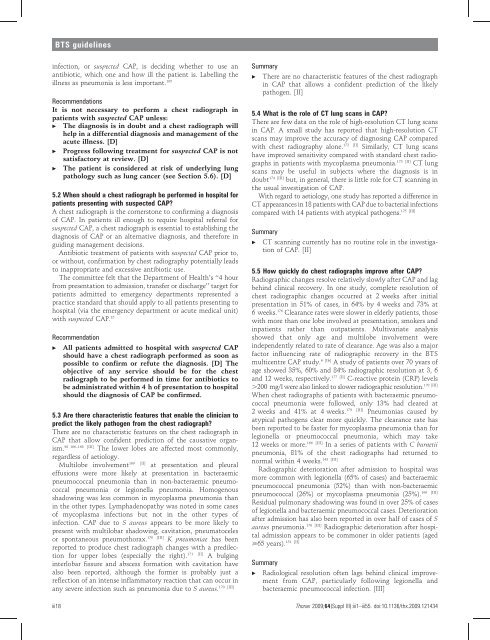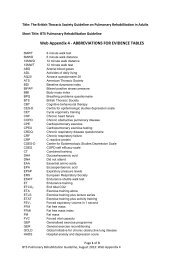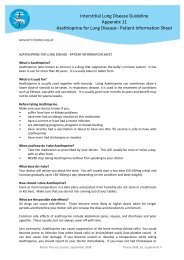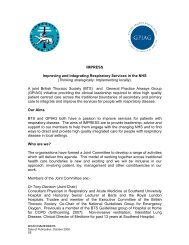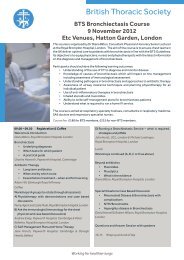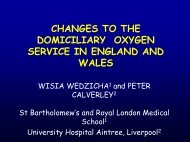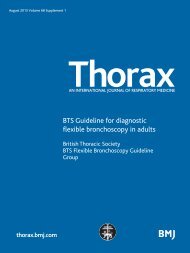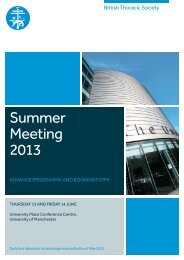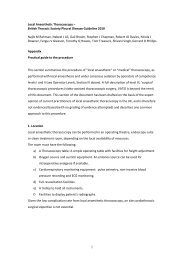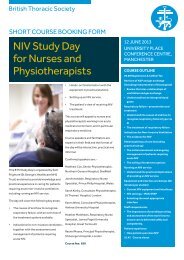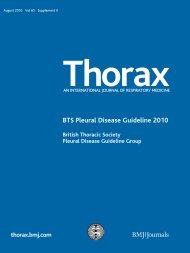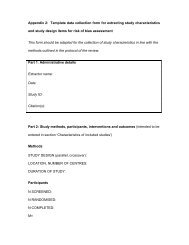Guidelines for the management of community ... - Brit Thoracic
Guidelines for the management of community ... - Brit Thoracic
Guidelines for the management of community ... - Brit Thoracic
You also want an ePaper? Increase the reach of your titles
YUMPU automatically turns print PDFs into web optimized ePapers that Google loves.
BTS guidelines<br />
infection, or suspected CAP, is deciding whe<strong>the</strong>r to use an<br />
antibiotic, which one and how ill <strong>the</strong> patient is. Labelling <strong>the</strong><br />
illness as pneumonia is less important. 165<br />
Recommendations<br />
It is not necessary to per<strong>for</strong>m a chest radiograph in<br />
patients with suspected CAP unless:<br />
c The diagnosis is in doubt and a chest radiograph will<br />
help in a differential diagnosis and <strong>management</strong> <strong>of</strong> <strong>the</strong><br />
acute illness. [D]<br />
c Progress following treatment <strong>for</strong> suspected CAP is not<br />
satisfactory at review. [D]<br />
c The patient is considered at risk <strong>of</strong> underlying lung<br />
pathology such as lung cancer (see Section 5.6). [D]<br />
5.2 When should a chest radiograph be per<strong>for</strong>med in hospital <strong>for</strong><br />
patients presenting with suspected CAP?<br />
A chest radiograph is <strong>the</strong> cornerstone to confirming a diagnosis<br />
<strong>of</strong> CAP. In patients ill enough to require hospital referral <strong>for</strong><br />
suspected CAP, a chest radiograph is essential to establishing <strong>the</strong><br />
diagnosis <strong>of</strong> CAP or an alternative diagnosis, and <strong>the</strong>re<strong>for</strong>e in<br />
guiding <strong>management</strong> decisions.<br />
Antibiotic treatment <strong>of</strong> patients with suspected CAP prior to,<br />
or without, confirmation by chest radiography potentially leads<br />
to inappropriate and excessive antibiotic use.<br />
The committee felt that <strong>the</strong> Department <strong>of</strong> Health’s ‘‘4 hour<br />
from presentation to admission, transfer or discharge’’ target <strong>for</strong><br />
patients admitted to emergency departments represented a<br />
practice standard that should apply to all patients presenting to<br />
hospital (via <strong>the</strong> emergency department or acute medical unit)<br />
with suspected CAP. 15<br />
Recommendation<br />
c<br />
All patients admitted to hospital with suspected CAP<br />
should have a chest radiograph per<strong>for</strong>med as soon as<br />
possible to confirm or refute <strong>the</strong> diagnosis. [D] The<br />
objective <strong>of</strong> any service should be <strong>for</strong> <strong>the</strong> chest<br />
radiograph to be per<strong>for</strong>med in time <strong>for</strong> antibiotics to<br />
be administrated within 4 h <strong>of</strong> presentation to hospital<br />
should <strong>the</strong> diagnosis <strong>of</strong> CAP be confirmed.<br />
5.3 Are <strong>the</strong>re characteristic features that enable <strong>the</strong> clinician to<br />
predict <strong>the</strong> likely pathogen from <strong>the</strong> chest radiograph?<br />
There are no characteristic features on <strong>the</strong> chest radiograph in<br />
CAP that allow confident prediction <strong>of</strong> <strong>the</strong> causative organ-<br />
98 166–168<br />
ism. [III]<br />
The lower lobes are affected most commonly,<br />
regardless <strong>of</strong> aetiology.<br />
Multilobe involvement 169 [II] at presentation and pleural<br />
effusions were more likely at presentation in bacteraemic<br />
pneumococcal pneumonia than in non-bacteraemic pneumococcal<br />
pneumonia or legionella pneumonia. Homogenous<br />
shadowing was less common in mycoplasma pneumonia than<br />
in <strong>the</strong> o<strong>the</strong>r types. Lymphadenopathy was noted in some cases<br />
<strong>of</strong> mycoplasma infections but not in <strong>the</strong> o<strong>the</strong>r types <strong>of</strong><br />
infection. CAP due to S aureus appears to be more likely to<br />
present with multilobar shadowing, cavitation, pneumatoceles<br />
or spontaneous pneumothorax. 170 [III] K pneumoniae has been<br />
reported to produce chest radiograph changes with a predilection<br />
<strong>for</strong> upper lobes (especially <strong>the</strong> right). 171 [II] A bulging<br />
interlobar fissure and abscess <strong>for</strong>mation with cavitation have<br />
also been reported, although <strong>the</strong> <strong>for</strong>mer is probably just a<br />
Summary<br />
reflection <strong>of</strong> an intense inflammatory reaction that can occur in<br />
170 [III]<br />
any severe infection such as pneumonia due to S aureus.<br />
iii18<br />
c<br />
There are no characteristic features <strong>of</strong> <strong>the</strong> chest radiograph<br />
in CAP that allows a confident prediction <strong>of</strong> <strong>the</strong> likely<br />
pathogen. [II]<br />
5.4 What is <strong>the</strong> role <strong>of</strong> CT lung scans in CAP?<br />
There are few data on <strong>the</strong> role <strong>of</strong> high-resolution CT lung scans<br />
in CAP. A small study has reported that high-resolution CT<br />
scans may improve <strong>the</strong> accuracy <strong>of</strong> diagnosing CAP compared<br />
with chest radiography alone. 172 [II] Similarly, CT lung scans<br />
have improved sensitivity compared with standard chest radiographs<br />
in patients with mycoplasma pneumonia. 173 [II] CT lung<br />
scans may be useful in subjects where <strong>the</strong> diagnosis is in<br />
doubt 174 [III] but, in general, <strong>the</strong>re is little role <strong>for</strong> CT scanning in<br />
<strong>the</strong> usual investigation <strong>of</strong> CAP.<br />
With regard to aetiology, one study has reported a difference in<br />
CT appearances in 18 patients with CAP due to bacterial infections<br />
175 [III]<br />
compared with 14 patients with atypical pathogens.<br />
Summary<br />
c CT scanning currently has no routine role in <strong>the</strong> investigation<br />
<strong>of</strong> CAP. [II]<br />
5.5 How quickly do chest radiographs improve after CAP?<br />
Radiographic changes resolve relatively slowly after CAP and lag<br />
behind clinical recovery. In one study, complete resolution <strong>of</strong><br />
chest radiographic changes occurred at 2 weeks after initial<br />
presentation in 51% <strong>of</strong> cases, in 64% by 4 weeks and 73% at<br />
6 weeks. 176 Clearance rates were slower in elderly patients, those<br />
with more than one lobe involved at presentation, smokers and<br />
inpatients ra<strong>the</strong>r than outpatients. Multivariate analysis<br />
showed that only age and multilobe involvement were<br />
independently related to rate <strong>of</strong> clearance. Age was also a major<br />
factor influencing rate <strong>of</strong> radiographic recovery in <strong>the</strong> BTS<br />
multicentre CAP study. 6 [Ib] A study <strong>of</strong> patients over 70 years <strong>of</strong><br />
age showed 35%, 60% and 84% radiographic resolution at 3, 6<br />
and 12 weeks, respectively. 177 [II] C-reactive protein (CRP) levels<br />
178 [III]<br />
.200 mg/l were also linked to slower radiographic resolution.<br />
When chest radiographs <strong>of</strong> patients with bacteraemic pneumococcal<br />
pneumonia were followed, only 13% had cleared at<br />
2 weeks and 41% at 4 weeks. 179 [III] Pneumonias caused by<br />
atypical pathogens clear more quickly. The clearance rate has<br />
been reported to be faster <strong>for</strong> mycoplasma pneumonia than <strong>for</strong><br />
legionella or pneumococcal pneumonia, which may take<br />
12 weeks or more. 166 [III] In a series <strong>of</strong> patients with C burnetii<br />
pneumonia, 81% <strong>of</strong> <strong>the</strong> chest radiographs had returned to<br />
143 [III]<br />
normal within 4 weeks.<br />
Radiographic deterioration after admission to hospital was<br />
more common with legionella (65% <strong>of</strong> cases) and bacteraemic<br />
pneumococcal pneumonia (52%) than with non-bacteraemic<br />
pneumococcal (26%) or mycoplasma pneumonia (25%). 166 [III]<br />
Residual pulmonary shadowing was found in over 25% <strong>of</strong> cases<br />
<strong>of</strong> legionella and bacteraemic pneumococcal cases. Deterioration<br />
after admission has also been reported in over half <strong>of</strong> cases <strong>of</strong> S<br />
aureus pneumonia. 170 [III] Radiographic deterioration after hospital<br />
admission appears to be commoner in older patients (aged<br />
151 [II]<br />
>65 years).<br />
Summary<br />
c<br />
Radiological resolution <strong>of</strong>ten lags behind clinical improvement<br />
from CAP, particularly following legionella and<br />
bacteraemic pneumococcal infection. [III]<br />
Thorax 2009;64(Suppl III):iii1–iii55. doi:10.1136/thx.2009.121434


